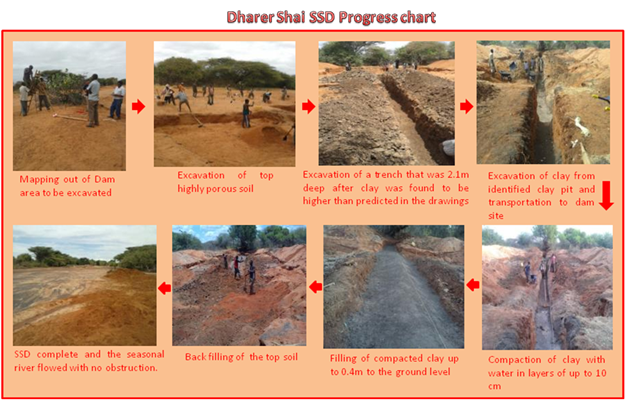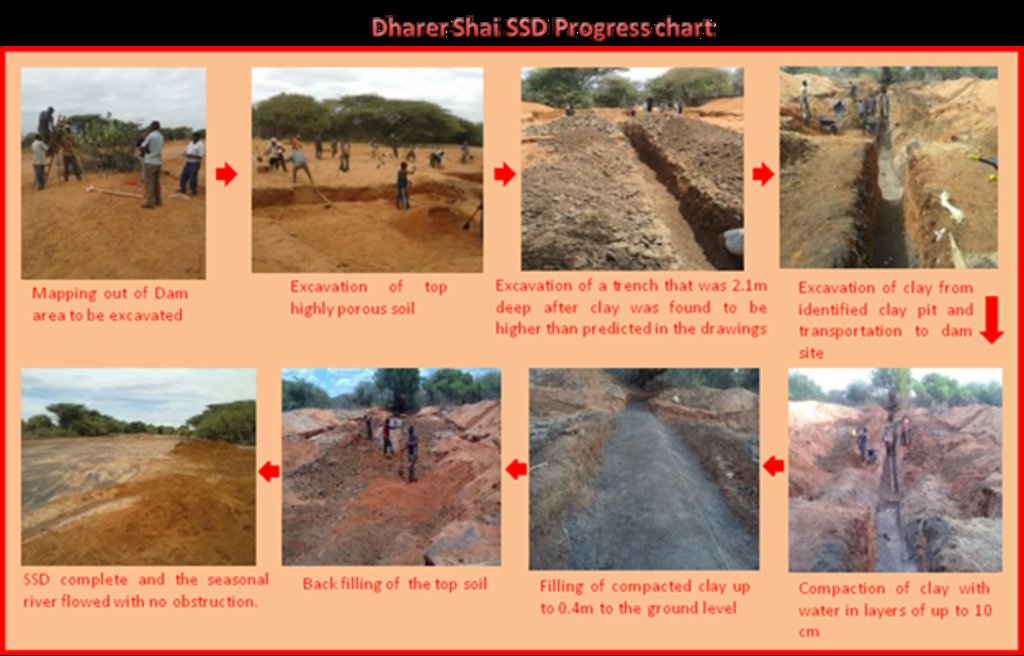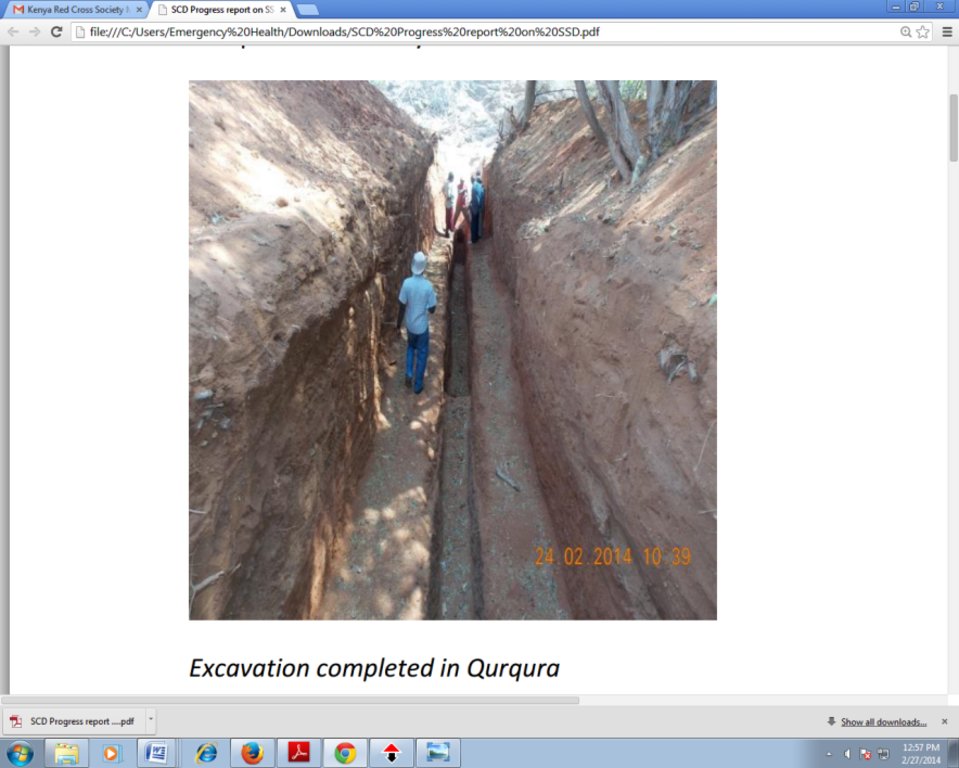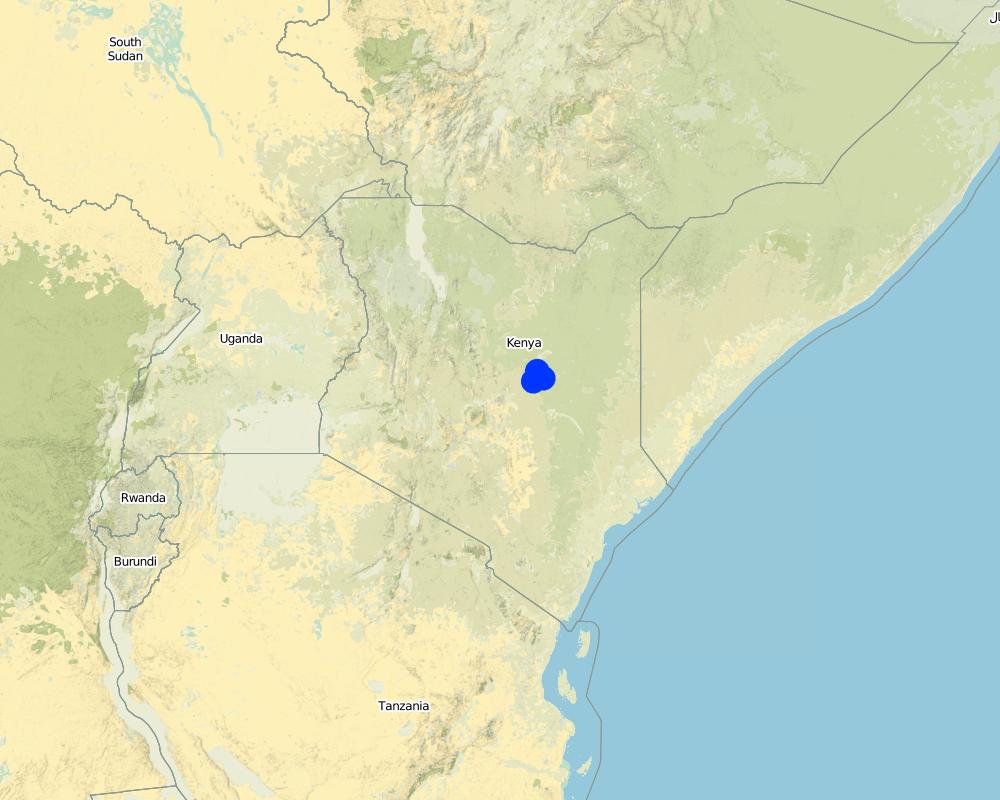Sub-Sarface Dams (SSD) [肯尼亚]
- 创建:
- 更新:
- 编制者: Guyo Roba
- 编辑者: –
- 审查者: Rima Mekdaschi Studer
technologies_3340 - 肯尼亚
- Sub-Sarface Dams (SSD): June 22, 2018 (inactive)
- Sub-Sarface Dams (SSD): May 7, 2018 (inactive)
- Sub-Sarface Dams (SSD): July 17, 2018 (inactive)
- Sub-Sarface Dams (SSD): Aug. 15, 2018 (inactive)
- Sub-Surface Dams (SSD): Dec. 5, 2018 (inactive)
- Sub-Sarface Dams (SSD): Sept. 3, 2018 (inactive)
- Sub-Surface Dams (SSD): Nov. 2, 2021 (public)
查看章节
全部展开 全部收起1. 一般信息
1.3 关于使用通过WOCAT记录的数据的条件
(现场)数据是什么时候汇编的?:
11/01/2018
编制者和关键资源人员接受有关使用通过WOCAT记录数据的条件。:
是
1.4 所述技术的可持续性声明
这里所描述的技术在土地退化方面是否存在问题,导致无法被认为是一种可持续的土地管理技术?:
否
2. SLM技术的说明
2.1 技术简介
技术定义:
These are constructions stretching across the sand filled dry riverbed, down towards the impermeable floor of the riverbed. They are totally submerged into the ground. For example by fully covering after construction by sand. This are done along dry rivers with huge sand deposits, which has high yield potential and where water can be easily extracted. The aim is to raise groundwater tables and increase the storage capacity for water withdrawals.
2.2 技术的详细说明
说明:
The technology is applied in northern rangeland of Isiolo County which is managed under communal management systems. The technology involves soil excavation which are typically subdivided into a number of square chambers measuring 4X2.3X2.2= 20.2M3 (not to scale). Then, excavation and transportation of clay soil from the clay pit and final compaction of clay soil after approximately a week, and lying out of the concrete and refilling of the sand. Finally, a liner is placed. The technology functions as underground water storage infrastructure. The development of Sub-Surface Dams (SSDs) was done through Cash for Work program where local labours comprising of 40-50 persons are engaged in excavation, compactions and developing the liners. Typical activities include, excavation of top porous soil, excavation of sample pits within the excavated area, checking filtration rates of soil, compaction of soil on which dam liners are laid, smoothing the sharp liners along which the dam liners are laid, making grooves to anchor the dam liner, laying the dam liner, anchoring the dam liner with a mixture of cement, water proof and sand with water (motor) and finally drying of the motor and filling back of sand. The technology aim to improve water access for livestock in ways that support wider management and utilization of the rangeland and as such strength the resilience of pastoralists to droughts. Inputs such as farm tools like jembe, panga, spades and human labour are required to develop SSD. The technology improves water supply/availability, thereby extending the period of livestock grazing in areas where typically water is depleted before the pasture. This effectively gives pastoral groups, an extra grazing time (typically 2 extra months) that is not too long to lead to land degradation through over-grazing but long enough to enable pastoralist utilize the remaining pasture in wet season grazing areas. In so doing, the technology enable balanced use of vast communal lands without livestock retreating to dry season grazing areas. The extended grazing period is instrumental in building resilience of pastoral communities in the face of climate variability. The technology was instrumental in fostering both balanced utilization of land and strengthening sustainable use of the vast rangeland by moderating the mobility between wet season and dry season grazing areas. The water stored through the technology stays longer, in this case study, the water lasted for 5 months after the end of the rainy season. Normally, the water is depleted within 2 months after the rainy period. The technology is also cheap and easy to understand and construct (especially in areas with clay as the underlying impermeable material) with a possibility of the communities to be taught how to identify suitable site and the entire process of construction. However, in areas without clay soil, the excavation of clay and transportation can be labour intensive and expensive.
2.3 技术照片
2.5 已应用该技术的、本评估所涵盖的国家/地区/地点
国家:
肯尼亚
区域/州/省:
Northern Kenya
有关地点的进一步说明:
Garba Tula, Isiolo County
Map
×2.7 技术介绍
详细说明该技术是如何引入的:
- 通过项目/外部干预
3. SLM技术的分类
3.1 该技术的主要目的
- 改良生产
- 减少、预防、恢复土地退化
- 减缓气候变化及其影响
- 创造有益的经济影响
- 创造有益的社会影响
3.2 应用该技术的当前土地利用类型

牧场
粗放式放牧场:
- 半游牧/游牧
注释:
Communal grazing area that is shared by 2 and more pastoral groups
3.3 有关土地利用的更多信息
该技术所应用土地的供水:
- 雨养
牲畜密度(如相关):
Fluctuates, depending on seasons and pasture availability
3.4 该技术所属的SLM组
- 畜牧业和牧场管理
3.5 技术传播
具体说明该技术的分布:
- 适用于特定场所/集中在较小区域
注释:
Sub-Surface Dams are only suitable in areas along the river, with suitable density of sand deposits
3.6 包含该技术的可持续土地管理措施

结构措施
- S5:大坝、集水斗、水池
3.7 该技术强调的主要土地退化类型

其它
注释:
Mismatch of pasture and water resources - there are areas where pastures are plenty but surface rain water is depleted earlier than pasture.
3.8 防止、减少或恢复土地退化
具体数量名该技术与土地退化有关的目标:
- 防止土地退化
- 减少土地退化
注释:
The SSD technology increase water availability is period immediately after the rain, hence ensuring better pasture utilization and more sustainable use of land
4. 技术规范、实施活动、投入和成本
4.1 该技术的技术图纸
4.2 技术规范/技术图纸说明
The SSD has initial excavation works. The construction of the SSD was constructed by 50 laborers. The design attached represent an Aerial view of the area of excavation that is subdivided into 45 square chambers of 4X2.3X2.2= 20.2M3 (not to scale). Each of the chambers were excavated by 5 laborers. The estimated time for excavation as per the plan was estimated to be five days. Excavation and transportation of the clay from the clay pit was estimated to take an approximate of five days while the compacting of the clay will follow one week later, and laying out of the concrete and refilling of the sand for another week. The liner will then be finally placed. in summary, the excavation of sand takes 5days, and the excavation of clay soil takes another 5days while concrete placing, compacting of clay as well as putting of liner and refilling of sand takes 10 days.
4.3 有关投入和成本计算的一般信息
注明雇用劳工的每日平均工资成本:
3.5 USD per day
4.4 技术建立活动
| 活动 | 措施类型 | 时间 | |
|---|---|---|---|
| 1. | Removing sand over dyke and Man-days for excavating and transporting soil to dam site | 其它措施 | 21 days for 45 casual labourers |
| 2. | Building and compaction soil in dam wall | 结构性的 | 3 days for 45 casual labourers |
| 3. | Supplying water for compaction | 其它措施 | 0.5 day for 45 casual labourers |
| 4. | Back-filling sand on dam | 其它措施 | 1 day for 45 casual labourers |
| 5. | Supplying water for compacting soil in dam wall | 其它措施 | 2 days for 45 casual labourers |
| 6. | Compacting soil and placing liners | 其它措施 | 12 days for 45 casual labourers |
注释:
The construction of SSD was done through “Cash for work” which is participatory process that involves community mobilization, identification of beneficiaries and formation of “Cash for work” committees, registrations and verification of beneficiaries and implementation/supervision of the work.
4.5 技术建立所需要的费用和投入
| 对投入进行具体说明 | 单位 | 数量 | 单位成本 | 每项投入的总成本 | 土地使用者承担的成本% | |
|---|---|---|---|---|---|---|
| 劳动力 | tools - jembe, spade etc. | pieces | 80.0 | 5.33 | 426.4 | |
| 劳动力 | Removing sand over dyke and Man-days for excavating and transporting soil to dam site | per day | 945.0 | 4.0 | 3780.0 | |
| 劳动力 | Building and compaction soil in dam wall | per day | 135.0 | 4.0 | 540.0 | |
| 设备 | Supplying water for compaction | per day | 22.5 | 4.0 | 90.0 | |
| 设备 | Back-filling sand on dam | per day | 45.0 | 4.0 | 180.0 | |
| 设备 | Supplying water for compacting soil in dam wall | per day | 90.0 | 4.0 | 360.0 | |
| 设备 | Compacting soil and placing liners | per day | 540.0 | 4.0 | 2160.0 | |
| 技术建立所需总成本 | 7536.4 | |||||
4.6 维护/经常性活动
| 活动 | 措施类型 | 时间/频率 | |
|---|---|---|---|
| 1. | Training of communities to manage and maintain the structures | 结构性的 | yearly |
4.7 维护/经常性活动所需要的费用和投入(每年)
| 对投入进行具体说明 | 单位 | 数量 | 单位成本 | 每项投入的总成本 | 土地使用者承担的成本% | |
|---|---|---|---|---|---|---|
| 劳动力 | Labour for site protection and maintenance of hygiene | per site | 10.0 | 100.0 | 1000.0 | |
| 技术维护所需总成本 | 1000.0 | |||||
注释:
Water User Associations on the sites are trained on the management of the structures on behalf of the community e.g. on the protection of structure and hygiene maintenance.
4.8 影响成本的最重要因素
描述影响成本的最决定性因素:
Distance of the sub-surface dam from villages, extent of destruction by floods and human activities
5. 自然和人文环境
5.1 气候
年降雨量
- < 250毫米
- 251-500毫米
- 501-750毫米
- 751-1,000毫米
- 1,001-1,500毫米
- 1,501-2,000毫米
- 2,001-3,000毫米
- 3,001-4,000毫米
- > 4,000毫米
有关降雨的规范/注释:
because of the climate change, the rainfall is becoming more erratic
注明所考虑的参考气象站名称:
Isiolo
农业气候带
- 半干旱
5.2 地形
平均坡度:
- 水平(0-2%)
- 缓降(3-5%)
- 平缓(6-10%)
- 滚坡(11-15%)
- 崎岖(16-30%)
- 陡峭(31-60%)
- 非常陡峭(>60%)
地形:
- 高原/平原
- 山脊
- 山坡
- 山地斜坡
- 麓坡
- 谷底
垂直分布带:
- 0-100 m a.s.l.
- 101-500 m a.s.l.
- 501-1,000 m a.s.l.
- 1,001-1,500 m a.s.l.
- 1,501-2,000 m a.s.l.
- 2,001-2,500 m a.s.l.
- 2,501-3,000 m a.s.l.
- 3,001-4,000 m a.s.l.
- > 4,000 m a.s.l.
说明该技术是否专门应用于:
- 不相关
5.3 土壤
平均土层深度:
- 非常浅(0-20厘米)
- 浅(21-50厘米)
- 中等深度(51-80厘米)
- 深(81-120厘米)
- 非常深(> 120厘米)
土壤质地(表土):
- 粗粒/轻(砂质)
土壤质地(地表以下> 20厘米):
- 粗粒/轻(砂质)
表土有机质:
- 中(1-3%)
5.4 水资源可用性和质量
地下水位表:
5-50米
地表水的可用性:
匮乏/没有
水质(未处理):
良好饮用水
水的盐度有问题吗?:
否
该区域正在发生洪水吗?:
否
5.5 生物多样性
物种多样性:
- 高
栖息地多样性:
- 高
5.6 应用该技术的土地使用者的特征
定栖或游牧:
- 半游牧的
生产系统的市场定位:
- 混合(生计/商业
非农收入:
- 低于全部收入的10%
相对财富水平:
- 平均水平
个人或集体:
- 团体/社区
机械化水平:
- 手工作业
性别:
- 男人
土地使用者的年龄:
- 中年人
5.7 应用该技术的土地使用者拥有或租用的平均土地面积
- < 0.5 公顷
- 0.5-1 公顷
- 1-2 公顷
- 2-5公顷
- 5-15公顷
- 15-50公顷
- 50-100公顷
- 100-500公顷
- 500-1,000公顷
- 1,000-10,000公顷
- > 10,000公顷
这被认为是小规模、中规模还是大规模的(参照当地实际情况)?:
- 大规模的
5.8 土地所有权、土地使用权和水使用权
土地所有权:
- 社区/村庄
土地使用权:
- 社区(有组织)
用水权:
- 社区(有组织)
5.9 进入服务和基础设施的通道
健康:
- 贫瘠
- 适度的
- 好
教育:
- 贫瘠
- 适度的
- 好
技术援助:
- 贫瘠
- 适度的
- 好
就业(例如非农):
- 贫瘠
- 适度的
- 好
市场:
- 贫瘠
- 适度的
- 好
能源:
- 贫瘠
- 适度的
- 好
道路和交通:
- 贫瘠
- 适度的
- 好
饮用水和卫生设施:
- 贫瘠
- 适度的
- 好
金融服务:
- 贫瘠
- 适度的
- 好
6. 影响和结论性说明
6.1 该技术的现场影响
社会经济效应
生产
畜牧生产
土地管理
水资源可用性和质量
家畜用水的可用性
生态影响
减少气候和灾害风险
干旱影响
6.2 该技术的场外影响已经显现
水资源可用性
6.3 技术对渐变气候以及与气候相关的极端情况/灾害的暴露和敏感性(土地使用者认为的极端情况/灾害)
气候有关的极端情况(灾害)
气候灾害
| 该技术是如何应对的? | |
|---|---|
| 干旱 | 好 |
6.4 成本效益分析
技术收益与技术建立成本相比如何(从土地使用者的角度看)?
长期回报:
积极
技术收益与技术维护成本/经常性成本相比如何(从土地使用者的角度看)?
长期回报:
非常积极
注释:
The technology has limited running and maintenance costs once its done fairly well.
6.5 技术采用
- 1-10%
在所有采用这项技术的人当中,有多少人是自发地采用该技术,即未获得任何物质奖励/付款?:
- 0-10%
6.6 适应
最近是否对该技术进行了修改以适应不断变化的条件?:
否
6.7 该技术的优点/长处/机会
| 土地使用者眼中的长处/优势/机会 |
|---|
| The technology created opportunity to graze in wet season grazing areas for extra 2 months period after rainy seasons. The technology has provided additional water that extended, albeit slightly, the grazing period of the land-users. In so doing, the land users utilized the pasture without retreating to traditional dry season grazing areas. |
| The extra grazing months has reduced overall livestock mortality during droughts and also improved resilience of pastoral community. |
| The distance traveled and effort required to access water was reduced. Community members reported reduced distances covered and time spent in search of water for livestock. In some instances the distance reduced from 12-15 Km to 3 Km. Community members also mentioned reduction in conflict incidences over water resources in some areas due to adequate supply of water as a result of construction of water infrastructure. |
| 编制者或其他关键资源人员认为的长处/优势/机会 |
|---|
| The technology has created an opportunity to optimally use the grazing area and overall reduced land degradation. The technology Improves access to water for livestock in ways which promote more sustainable management of rangeland resources and as such strengthening the resilience of local communities. |
| The validation process prior to construction of the SSD is draws critical lessons of identifying and agreeing on where to construct the SSD in a way that fit within broader sustainable rangeland management in a manner that ensured sustainable and efficient utilization of pasture and browse resources in targeted areas. The increase in water supply allowed livestock to graze additional 2-3 months in target areas before shifting to dry grazing areas where previously they migrated before exhausting the pasture and browse resources due to water scarcity. |
6.8 技术的弱点/缺点/风险及其克服方法
| 土地使用者认为的弱点/缺点/风险 | 如何克服它们? |
|---|---|
| When the construction season for SSD is not well planned, there is likelihood/risks of the dams being washed away by flash floods. | Better planning and timing of the development of SDD, just slightly before the onset of rainfall. |
7. 参考和链接
7.1 信息的方法/来源
- 根据报告和其他现有文档进行编译
7.3 链接到网络上可用的相关信息
标题/说明:
Promoting resilience by influencing water infrastructure development in community managed rangelands of Kenya
URL:
https://portals.iucn.org/library/sites/library/files/documents/2014-088.pdf
标题/说明:
Balancing water infrastructure in community-managed rangelands in the arid and semi-arid lands of Kenya
URL:
https://portals.iucn.org/library/sites/library/files/documents/2014-089.pdf
链接和模块
全部展开 全部收起链接
无链接
模块
无模块







